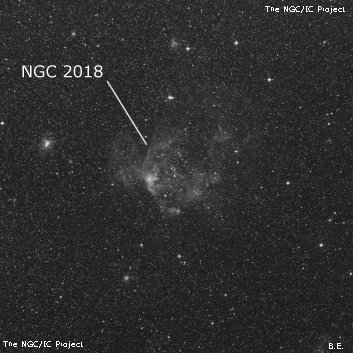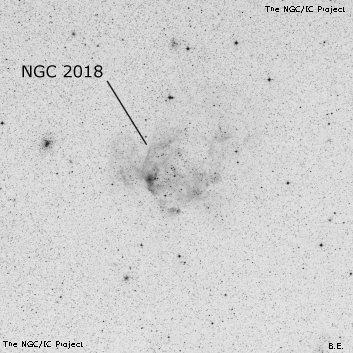NGC/IC Project Restoration Effort
(This is a very very beta version)
NGC2018


Basic Information
Location and Magnitude
Right Ascension: 5:31:20.2
Declination: -71:3:58
Constellation: MEN
Visual Magnitude: 10.9
Historic Information
Discoverer: Herschel J.
Year of discovery: 1834
Discovery aperture: 18.3
Observational
Summary description: pB, pL, R, pglbM, * 10 p inv
Sub-type: OCL+EN
Corwin's Notes
=====
NGC 2018. JH is quite clear that his nebula is east of a 10th magnitude star:
05 33 41.4 161 11 30 pB, R, pglbM, 2'; a star 10 m involved, p.
Though he has only one observation of it on 3 November 1834, his position is
clearly pointing at the nebulosity east of the star. That nebula is
compressed enough (or there is a star involved in the middle) that the digital
sky surveys have picked it up.
ESO took a much larger star cloud for JH's object, and I suspect that others
have followed along, judging by the published positions.
Steve's Notes
=====
NGC 2018
24" (4/5/08 - Magellan Observatory, Australia): this is a fascinating, showpiece HII complex with a cluster and a large, detailed nebula appearing like a fainter version of M8 -- of course, in another galaxy! At 200x the cluster (S-L 533) is ~8' in diameter and includes a couple of dozen mag 11-15 stars (part of the stellar association LH 69). The stars are involved in the glow of a bright HII complex that has an excellent response to a UHC filter. Using the filter, the brightest region (NGC 2018) is a very prominent 1' circular patch on the east end with fainter wings extending north and south, increasing the size to 3'x1'. A wide pair of stars including a brighter star (HD 269676) is at the west edge of this patch. Three additional elongated patches (each 1' to 1.5' in diameter) along the SW side of the complex, are strung out in a 6' line oriented NW to SE line (BSDL 2005, BSDL 2048 and LMC N206B = BSDL 2120). Another glowing patch of nebulosity, ~45" diameter, is to the west of of the brightest region and surrounds a couple of brighter stars. Finally there is an isolated, elongated patch on the north end of the complex that seems detached (BSDL 2129). Weaker sections of the nebulosity give the impression of dark lanes. Surprisingly, Herschel's description applies only to the brightest region at the east end of this entire complex.



